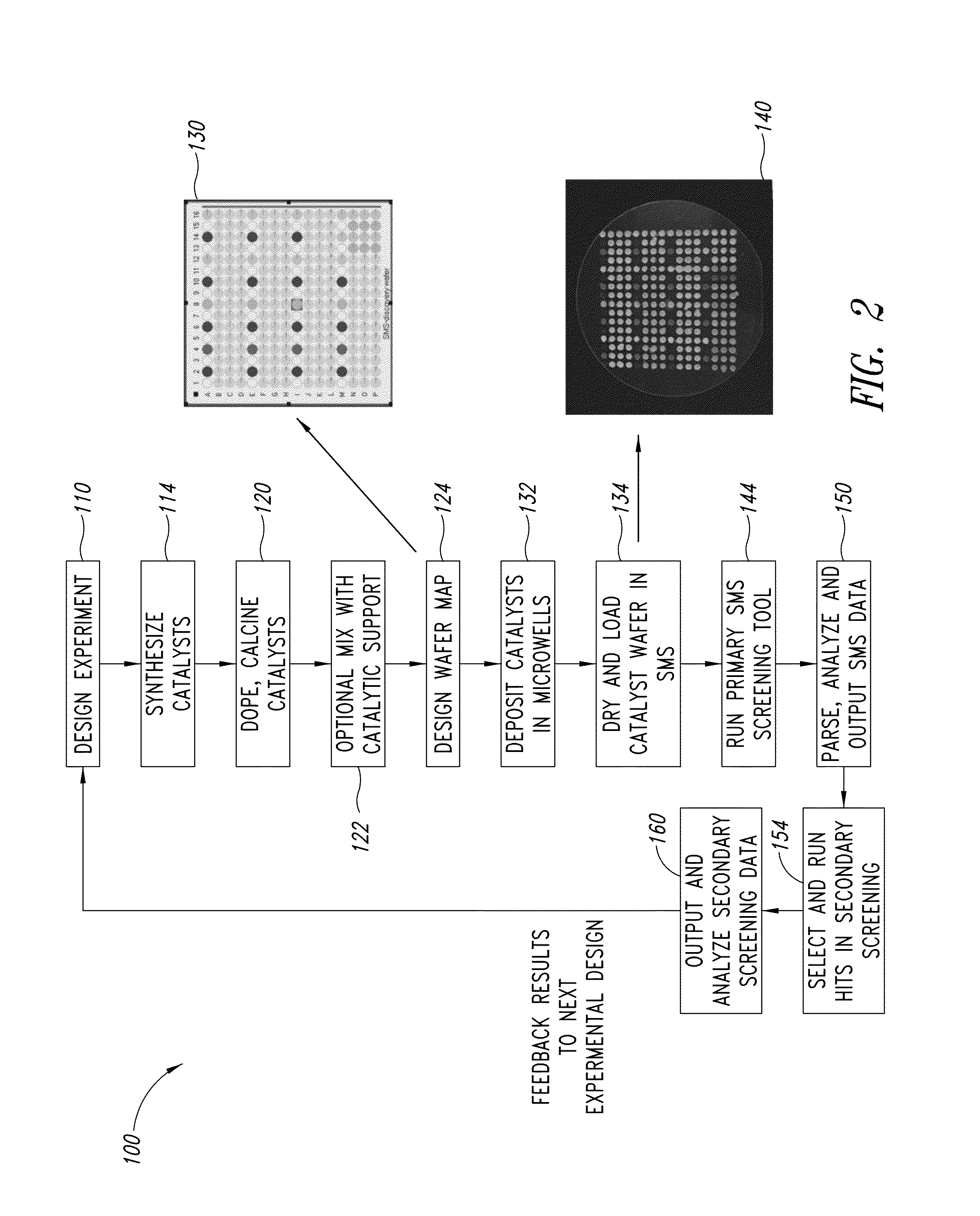Catalysts for petrochemical catalysis
a technology of petrochemical catalysis and catalysts, applied in the field of catalysts, doped metal oxide catalysts, can solve the problems of reducing the yield of undesired side products, affecting the efficiency of catalysts,
- Summary
- Abstract
- Description
- Claims
- Application Information
AI Technical Summary
Benefits of technology
Problems solved by technology
Method used
Image
Examples
example 1
Preparation of a Catalyst Comprising La, Nd and Sr
[0358]Equimolar aqueous solutions of strontium nitrate, neodymium nitrate, and lanthanum nitrate were prepared. Aliquots of each solution were mixed together to prepare a desired formulation of LaxNdySrz where x, y, z represent mole fractions of total metal content in moles. Representative examples of formulations are: La50Nd30Sr20, La52Nd45Sr05, La75Nd22Sr03, and the like. A solution of citric acid was added to the metal salt mixture so that citric acid mole / metal mole ratio was 3:1. Ethylene glycol was then added to the citric acid / metal salt solution so that the ethylene glycol / citric acid mole ratio was 1:1. The solution was stirred at room temperature for 1 h. The solution was placed in a 130° C. oven for 15 h to remove water and to promote resin formation. After 15 h, a hard dark resin was observed. The resin was placed in a furnace and heated to 500° C. for 8 h. The remaining material was heated to 650° C. for 2 h to yield the...
example 2
Preparation of a Sr Doped Nd2O3 Catalyst
[0361]To prepare this catalyst at a level of 20 mole % Sr (based on total moles of Nd2O3), 3.0 g of Nd2O3 bulk from Alfa Chemicals was slurried in a solution formed by dissolving 0.378 g of Sr(NO3)2 in about 20 ml of DI water. The slurry was stirred at room temperature for about 30 minutes to ensure that the Sr(NO3)2 dissolved. The slurry was then moved to an evaporating dish and placed into an oven at 100-140° C. for 2-3 hours to ensure dryness. The solids were then calcined in a furnace by ramping up to 350° C. at 5° C. / min and holding for 2 hours and then ramping again at the same rate to 700° C. and holding for 4 hours. It was then cooled to room temperature, ground and sieved to a particle size range of 180 μm to 250 μm.
example 3
Preparation of a LiMgMnB Catalyst
[0362]The following fine powders were mixed together: 1.072 g of Mn2O3 (325 mesh); 1.418 g of MgO (325 mesh); 0.384 g Boric acid powder and 0.164 g LiOH anhydrous. This corresponds to an approximate molar ratio of Li:B:Mn:Mg of 1:1:2:5. The powders were then added to about 20 ml of water, resulting in a black slurry. This slurry was stirred for about an hour to dissolve all of the LiOH and boric acid and then dried for several hours at about 120° C. In a crucible, the resulting powder was ground as fine as possible and calcined according to the following schedule. Ramp to 350° C. at 5° C. / min and hold for 120 minutes. Ramp to 950° C. at 5° C. / min and hold for at least 8 hours. Cool to room temperature and repeat grinding. In certain embodiments, the catalyst was sieved to between 150-300 μm to minimize pressure drop and then the catalyst was ready for catalyst testing.
PUM
| Property | Measurement | Unit |
|---|---|---|
| temperature | aaaaa | aaaaa |
| pressures | aaaaa | aaaaa |
| temperature | aaaaa | aaaaa |
Abstract
Description
Claims
Application Information
 Login to View More
Login to View More - R&D
- Intellectual Property
- Life Sciences
- Materials
- Tech Scout
- Unparalleled Data Quality
- Higher Quality Content
- 60% Fewer Hallucinations
Browse by: Latest US Patents, China's latest patents, Technical Efficacy Thesaurus, Application Domain, Technology Topic, Popular Technical Reports.
© 2025 PatSnap. All rights reserved.Legal|Privacy policy|Modern Slavery Act Transparency Statement|Sitemap|About US| Contact US: help@patsnap.com



